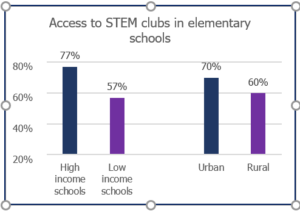New Report Calls for Delay in Implementing E-Learning
Report recommends changes to funding and policy for technology in schools
For immediate release
TORONTO (May 6, 2020) – Let’s learn from recent experience. That’s the key message in a new report from People for Education. The report – based on data from 1159 Ontario schools – shows that students’ access to technology in Ontario schools is currently governed by disjointed policy and funding, and often depends on parent fundraising.
The report says that key lessons have been learned during the pandemic, and that it is vital to translate what has been learned into effective policy and strategies as we move forward. Now, more than ever, schools need to equip students with the wide range of skills and competencies required to deal with current and future challenges. Technology – supported by coherent policy and funding – can play a key role in fostering those skills.
Funding for technology has not kept up with need 
According to the report, per pupil funding to support the hard costs of computers and software in schools has not increased for 10 years. In addition, provincial funding for the infrastructure required to support technology in schools is divided among at least three different grants and has not kept pace with the rate of technological change education is experiencing. Many schools rely on fundraising to offset the costs of technology, and principals report that it is difficult to ensure that all students have equitable access.
In 2020:
- Only 66% of Ontario schools have access to wall-to-wall WiFi
- 65% of elementary schools fundraise to offset the costs of technology.
- 74% of elementary schools with high average family incomes fundraise for technology, compared to 57% of schools with low average family incomes.
Online learning pre- and post-pandemic
During the pandemic, teachers have used a wide variety of online tools and techniques to support student learning. Their experience has made it clear that post-pandemic, it will be vital to ensure that students are set up with the guidance, time and resources necessary to successfully engage and learn in digital platforms.
The report points to research that outlines both benefits and risks in online learning. It says that when integrated with the appropriate technology, training and time, online learning can be helpful in preparing students for the future. However, many high school principals raised concerns about a lack of adequate supervision and support for their students engaged in e-learning.
As enrolment increases in e-Learning courses, we find it challenging to provide adequate supervision for e-Learning students. We cannot afford to assign a teacher to supervise them. Secondary school, Ottawa-Carleton DSB
This school year, an average of 6% of students per high school are enrolled in e-learning, which is an increase from an average of 2% in 2009, but a far cry from the province’s target of 100% of students taking at least two e-learning courses before they graduate. Supports for these students are inconsistent.
In 2020:
- 56% of secondary schools have designated staff members to support students who are working on e-learning courses during the school day. In those schools, 55% report student success teachers, 48% report guidance teachers, and 16% report special education teachers perform this role.
- Only 43% of high schools have school laptops or computers available for e-learning students after school hours, and only 19% report students can access these devices on weekends.
- 43% of schools report that students working on e-learning during the school day work primarily in the school library. Of the principals who report informally asking staff to support students with their online learning, 26% say they have asked the teacher-librarian to take up this task.
- School libraries are playing an expanding role as places to support technology, online learning and digital literacy. Despite this, there has been a steady decline in the proportion of elementary and secondary schools with teacher-librarians.
The province has announced that parents may opt their children out of compulsory e-learning in high school, but the report raises concerns that this may create further inequity as parents with higher social capital, who tend to be from a higher socioeconomic status, are more likely to access things like opt-out strategies.
Access to STEM enrichment depends on geography and socio-economics
This year 66% of elementary schools and 74% of secondary schools in Ontario report that they have robotics, technology, or STEM clubs. However, STEM opportunities are not distributed equally and there are disparities between schools along socio-economic and geographical lines.
- 77% of elementary schools with high average family incomes have access to broader opportunities for STEM compared to only 57% of schools with low average family incomes.
Recommendations for change
In the report, People for Education made a number of recommendations to the provincial government:
- Develop one comprehensive grant within the Grants for Student Needs to support technology and the implementation of e-learning in schools.
- Provide funding for secondary school e-learning teachers at a rate of funding for 1 teacher per 23 students – the same as regular classroom teachers.
- Delay the implementation of e-learning policy until the fall of 2021, and conduct extensive consultation and engagement with experts, educators, board staff, parents, and students to ensure e-learning is appropriately supported and delivered, and its benefits understood.
- Provide funding and policy for staff, and designated places in schools so that students enrolled in e-learning have supervised space with the appropriate infrastructure, equipment, and pedagogical support.
Ontario has the opportunity to be a national leader in ensuring that students are future-ready. It will be vitally important that policy-makers use the knowledge gained during the pandemic to help shape future policy around technology, online learning and access to enrichment. Annie Kidder, Executive Director, People for Education
Read the full report: Technology in Schools – A tool and a strategy
-30-
For more information, or to arrange interviews:
Email [email protected]
